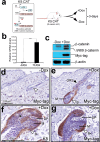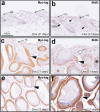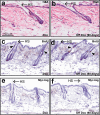A Mouse Model for Conditional Expression of Activated β-Catenin in Epidermal Keratinocytes
- PMID: 39110314
- PMCID: PMC11588969
- DOI: 10.1007/s11248-024-00402-z
A Mouse Model for Conditional Expression of Activated β-Catenin in Epidermal Keratinocytes
Abstract
We report the generation and characterization of the K5: CAT bigenic mouse in which the constitutively activated form of β-catenin (ΔN89 β-catenin) is conditionally expressed in cytokeratin-5 (K5) positive epidermal keratinocytes. Following short-term doxycycline intake during the telogen resting phase, the adult K5: CAT bigenic develops enlarged pilosebaceous units that expand deep into the dermis, an expansion usually observed during the anagen growth phase. Prolonged doxycycline treatment results in significant thickening and folding of the K5: CAT epidermis. During this persistent induction period, there is clear evidence of increased keratinocyte proliferation, particularly in the epidermal basal cell layer and the outer root sheath of the hair follicle. This unscheduled increase in cellular proliferation likely explains the decrease in hair density observed in the K5: CAT mouse following persistent doxycycline intake. Numerous hyperplastic endometrioid cysts, which display cornification toward their lumens, are also observed during this treatment period. Remarkably, de-induction of ΔN89 β-catenin expression through doxycycline withdrawal results in a marked reversal of the skin phenotype, suggesting that these morphological changes are dependent on continued signaling by β-catenin and/or its downstream molecular mediators. Joining a small group of mouse models for conditional β-catenin signaling, our K5: CAT mouse model will be particularly useful in identifying those molecular mediators of β-catenin that are responsible for initiating and maintaining these phenotypic responses in the K5: CAT skin. Such studies are predicted to shed more light on β-catenin signaling in epidermal epithelial morphogenesis, hair follicle cycling, and hair growth pathologies.
Keywords: Cytokeratin-5; Doxycycline; Keratinocytes; Mouse; Transgenic; β-catenin.
© 2024. The Author(s).
Conflict of interest statement
Declarations. Conflict of interests: The authors declare no competing interests.
Figures





Similar articles
-
Embryonic hair follicle fate change by augmented beta-catenin through Shh and Bmp signaling.Development. 2009 Feb;136(3):367-72. doi: 10.1242/dev.021295. Development. 2009. PMID: 19141668
-
Histopathologic and transcriptomic phenotypes of a conditional RANKL transgenic mouse thymus.Cytokine. 2022 Dec;160:156022. doi: 10.1016/j.cyto.2022.156022. Epub 2022 Sep 11. Cytokine. 2022. PMID: 36099756 Free PMC article.
-
Differential sensitivity of epidermal cell subpopulations to beta-catenin-induced ectopic hair follicle formation.Dev Biol. 2010 Jul 1;343(1-2):40-50. doi: 10.1016/j.ydbio.2010.04.005. Epub 2010 Apr 14. Dev Biol. 2010. PMID: 20398648 Free PMC article.
-
Overexpression of protein kinase C-alpha in the epidermis of transgenic mice results in striking alterations in phorbol ester-induced inflammation and COX-2, MIP-2 and TNF-alpha expression but not tumor promotion.J Cell Sci. 1999 Oct;112 ( Pt 20):3497-506. doi: 10.1242/jcs.112.20.3497. J Cell Sci. 1999. PMID: 10504298
-
Transdifferentiation of corneal epithelium: evidence for a linkage between the segregation of epidermal stem cells and the induction of hair follicles during embryogenesis.Int J Dev Biol. 2004;48(2-3):197-201. Int J Dev Biol. 2004. PMID: 15272385 Review.
References
-
- Behrens J, Jerchow BA, Wurtele M, Grimm J, Asbrand C, Wirtz R, Kuhl M, Wedlich D, Birchmeier W (1998) Functional interaction of an axin homolog, conductin, with beta-catenin, APC, and GSK3beta. Science 280:596–599. 10.1126/science.280.5363.596 - PubMed
-
- Clevers H (2006) Wnt/beta-catenin signaling in development and disease. Cell 127:469–480. 10.1016/j.cell.2006.10.018 - PubMed
-
- Clevers H, van de Wetering M (1997) TCF/LEF factor earn their wings. Trends Genet 13:485–489. 10.1016/s0168-9525(97)01305-x - PubMed
MeSH terms
Substances
Grants and funding
LinkOut - more resources
Full Text Sources
Research Materials
Miscellaneous

